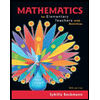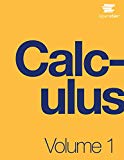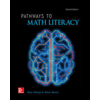
To convert: The given linear programming problem constraints into a system of equations using slack variables.
Answer to Problem 1RE
The converted constraints into a system of equationsusing slack variables are
Explanation of Solution
Procedure used:
“Selecting Basic and Non-basic Variables for the Simplex Method.
Given a simplex tableau.
Step 1: Numbers of variables- Determine the number of basic variables and thenumber of non-basic variables. These numbers do not change during thesimplex process.
Step 2: Selecting basic variables - A variable can be selected as a basic variable onlyif it corresponds to a column in the tableau that has exactly one nonzero element(usually 1) and the nonzero element in the column is not in the samerow as the nonzero element in the column of another basic variable. This procedure always selects P as a basic variable, since the P column neverchanges during the simplex process.
Step 3: Selecting non-basic variables - After the basic variables are selected instep 2, the remaining variables are selected as the non-basic variables. Thetableau columns under the non-basic variables usually contain more thanone nonzero element.
Selecting the Pivot Element.
Step 1: Locate the most negative indicator in the bottom row of the tableau to theleft of the P column (the negative number with the largest absolute value). The column containing this element is the pivot column. If there is a tie forthe most negative indicator, choose either column.
Step 2: Divide each positive element in the pivot column above the dashed line intothe corresponding element in the last column. The pivot row is the row correspondingto the smallest quotient obtained. If there is a tie for the smallestquotient, choose either row. If the pivot column above the dashed line has nopositive elements, there is no solution, and stop.
Step 3: The pivot (or pivot element) is the element at the intersection of the pivotcolumn and pivot row.
Performing a Pivot Operation.
A pivot operation, or pivoting, consists of performing row operations as follows:
Step 1: Multiply the pivot row by the reciprocal of the pivot element to transformthe pivot element into a 1. (If the pivot element is already a 1, omit this step.)
Step 2: Add multiples of the pivot row to other rows in the tableau to transform allother nonzero elements in the pivot column into 0's”.
Calculation:
The given linear programming problem is;
To convert theproblem constraints into a system of equationsslack variables is used. Since there are
Hence, converted constraints into a system of equationsusing slack variables are
Want to see more full solutions like this?
Chapter 6 Solutions
College Mathematics for Business, Economics, Life Sciences, and Social Sciences (13th Edition)
 Discrete Mathematics and Its Applications ( 8th I...MathISBN:9781259676512Author:Kenneth H RosenPublisher:McGraw-Hill Education
Discrete Mathematics and Its Applications ( 8th I...MathISBN:9781259676512Author:Kenneth H RosenPublisher:McGraw-Hill Education Mathematics for Elementary Teachers with Activiti...MathISBN:9780134392790Author:Beckmann, SybillaPublisher:PEARSON
Mathematics for Elementary Teachers with Activiti...MathISBN:9780134392790Author:Beckmann, SybillaPublisher:PEARSON
 Thinking Mathematically (7th Edition)MathISBN:9780134683713Author:Robert F. BlitzerPublisher:PEARSON
Thinking Mathematically (7th Edition)MathISBN:9780134683713Author:Robert F. BlitzerPublisher:PEARSON Discrete Mathematics With ApplicationsMathISBN:9781337694193Author:EPP, Susanna S.Publisher:Cengage Learning,
Discrete Mathematics With ApplicationsMathISBN:9781337694193Author:EPP, Susanna S.Publisher:Cengage Learning, Pathways To Math Literacy (looseleaf)MathISBN:9781259985607Author:David Sobecki Professor, Brian A. MercerPublisher:McGraw-Hill Education
Pathways To Math Literacy (looseleaf)MathISBN:9781259985607Author:David Sobecki Professor, Brian A. MercerPublisher:McGraw-Hill Education





